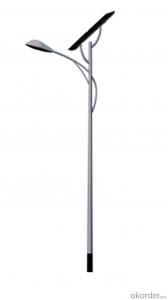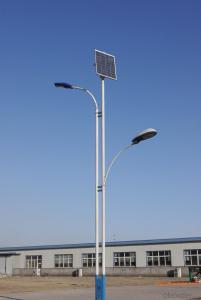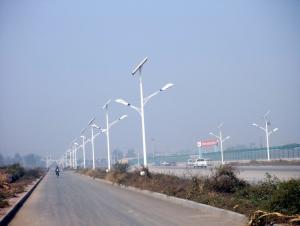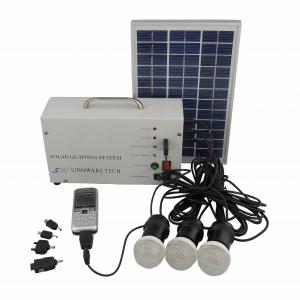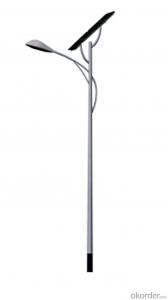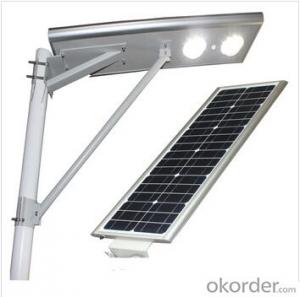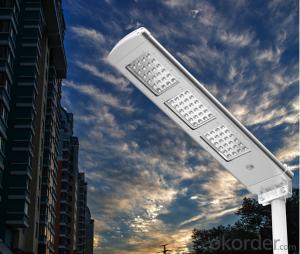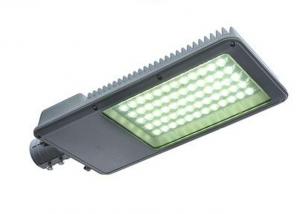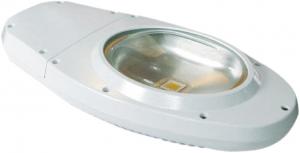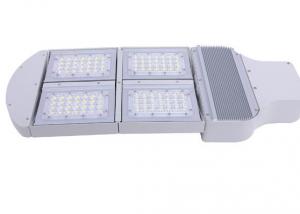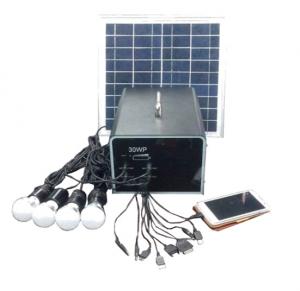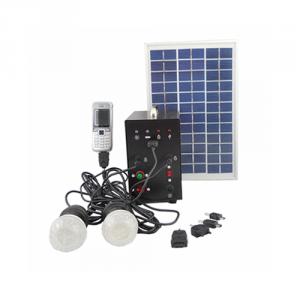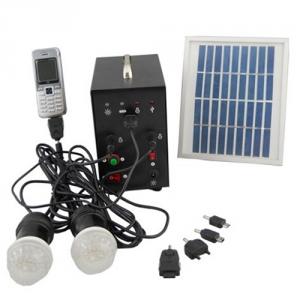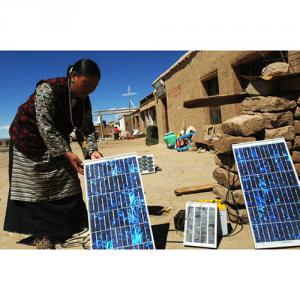Solar street light y2
- Loading Port:
- Ningbo
- Payment Terms:
- TT or LC
- Min Order Qty:
- 1 set
- Supply Capability:
- 5000 set/month
OKorder Service Pledge
OKorder Financial Service
You Might Also Like
1, Product desciption
Inverter circuits designed to produce a variable output voltage range are often used within motor speed controllers.
The DC power for the inverter section can be derived from a normal AC wall outlet or some other source. Control and feedback circuitry is used to adjust the final output of the inverter section which will ultimately determine the speed of the motor operating under its mechanical load.
Motor speed control needs are numerous and include things like: industrial motor driven equipment, electric vehicles, rail transport systems, and power tools. (See related: variable-frequency drive ) Switching states are developed for positive, negative and zero voltages as per the patterns given in the switching Table.
The generated gate pulses are given to each switch in accordance with the developed pattern and thus the output is obtained.
Solar power is energy from the sun. "Solar" is the Latin word for "sun" and
And Powerful source of energy. Without it, there will be no life.
Solar energy is considered as a serious source of energy for many years
of the vast amounts of energy that is made freely available, if harnessed by modern technology.
A magnifying glass can be used to heat up a small amount of water.
The short piece of copper tube is sealed at one end and filled with water.
And magnifying glass is then used to warm up the pipe.
Using more than one magnifying glass will increase the temperature more rapidly.
2, Features of the product
Inverters convert low frequency main AC power to higher frequency for use in induction heating.
To do this, AC power is first rectified to provide DC power. The inverter then changes the DC power to high frequency AC power. Due to the reduction in the number of DC Sources employed, the structure becomes more reliable and the output voltage has higher resolution due to an increase in the number of steps so that the reference sinusoidal voltage can be better achieved.
This configuration has recently become very popular in AC power supply and adjustable speed drive applications. This new inverter can avoid extra clamping diodes or voltage balancing capacitors. There are three kinds of level shifted modulation techniques, namely:
The first thing to figure out is the length of road in need of street lights.
This can be a small entrance road only a couple hundred of feet long to miles of streets through an area. Does the area currently have any type of lighting available.
What is the reason for needing street lights in this area
Is the electrical grid already nearby or would you need to call in the power company to bring in electrical lines.
If the electric needs to be brought to the area, how much is this going to cost? Depending on how far the grid electric is from the location of the needed lighting, this can be quite expensive.
How much lighting is needed on the street? Do the lights need to be dark sky compliant.
Do the street lights need to run from dusk to dawn or for only a specified number of hours at night.
Are the street lights able to dim in the middle of the night and still provide enough lighting.
These questions need to be answered before you can decide on how many lights you will need to complete the project.
3, Detailed Specification
| ||||||||||||||||||||||||||||||||||||||||||||||||
4, Product Image

- Q:Can solar lights be used on a balcony?
- Yes, solar lights can be used on a balcony. They are a great option for outdoor lighting in areas without access to electricity as they harness energy from the sun to power their lights. They are easy to install and require minimal maintenance, making them ideal for balconies.
- Q:Are solar lights safe for wildlife or pets?
- Solar lights are generally safe for wildlife and pets. Unlike traditional lights, solar lights do not emit heat or produce harmful chemicals, making them a low-risk option. However, it is important to consider the placement of solar lights to avoid attracting certain wildlife, such as insects or nocturnal animals, which could disrupt their natural behavior. Additionally, ensure that the solar lights are securely installed and any loose parts are inaccessible to pets to prevent accidents.
- Q:Are solar lights suitable for lighting up statues and sculptures?
- Yes, solar lights are suitable for lighting up statues and sculptures. They are a convenient and eco-friendly option as they harness the energy from the sun to power the lights, eliminating the need for electricity and reducing costs. Additionally, solar lights can be easily installed and provide a soft, ambient glow that enhances the beauty and details of the statues and sculptures.
- Q:Are solar lights affected by electromagnetic interference?
- Yes, solar lights can be affected by electromagnetic interference (EMI). EMI refers to the disturbance caused by electromagnetic radiation or electrical noise that can disrupt the normal functioning of electronic devices. Solar lights, being electronic devices, can experience interference from nearby sources such as power lines, electrical equipment, or radio frequency signals. This interference can potentially affect the efficiency and performance of solar lights, leading to diminished or unreliable lighting output. However, proper shielding, grounding, and quality design can help minimize the impact of EMI on solar lights.
- Q:Can solar lights be used for bicycle or pedestrian safety lighting?
- Bicycle or pedestrian safety lighting can indeed utilize solar lights. These lights derive their power from the sun, eliminating the need for electrical wiring or an external power source. As a result, they are highly suitable for outdoor settings, such as bike paths or pedestrian walkways, where they can be effortlessly installed on poles, posts, or other structures. By providing bright illumination during night-time hours, solar lights ensure optimal visibility and safety for cyclists and pedestrians. Furthermore, these lights typically come equipped with sensors that automatically activate them at dusk and deactivate them at dawn, thereby enhancing their convenience and energy efficiency. In conclusion, solar lights offer a cost-effective and environmentally friendly solution to enhance safety in areas frequented by bicycles or pedestrians.
- Q:Can solar lights be used in places without electricity?
- Yes, solar lights can be used in places without electricity. Solar lights operate by harnessing energy from the sun and converting it into electricity to power the light. They have built-in solar panels that absorb sunlight during the day and store the energy in rechargeable batteries. This stored energy is then used to power the light during the night. As long as there is access to sunlight, solar lights can be used in any location, making them particularly useful in areas with limited or no access to electricity grids. They are a sustainable and cost-effective option for providing lighting in remote areas, campsites, gardens, pathways, and other places where traditional electricity is not available.
- Q:Do solar lights have adjustable brightness settings for different activities?
- Solar lights frequently feature adjustable brightness settings to accommodate various activities. Numerous solar lights offer multiple modes or options that enable users to modify the brightness level according to their specific requirements. These adaptable settings prove especially advantageous for a range of activities, including outdoor gatherings, creating ambient lighting, or illuminating pathways. Granting users the ability to personalize the brightness enhances the overall adaptability and versatility of the lighting solution while meeting diverse preferences and needs.
- Q:Can solar lights be used for outdoor advertising or signage?
- Yes, solar lights can certainly be used for outdoor advertising or signage. Solar-powered lights are a sustainable and cost-effective option for illuminating signs or advertising materials in outdoor settings. They harness energy from sunlight during the day and use it to power the lights at night, eliminating the need for electricity supply or wiring. Solar lights are versatile, easily installed, and can provide bright illumination to attract attention to outdoor advertisements or signage while reducing environmental impact.
- Q:How do solar lights handle electromagnetic interference from other devices?
- Solar lights possess a reasonable ability to withstand electromagnetic interference (EMI) caused by nearby electronic devices. EMI arises when the radiation emitted by electronic devices disrupts the proper functioning of other devices. Typically, solar lights incorporate built-in shielding and filtering mechanisms to reduce the impact of EMI. These mechanisms effectively prevent interference from external devices like cell phones, Wi-Fi routers, and other electronic equipment, thus preserving the performance of the solar lights. Manufacturers of solar lights conduct rigorous testing to ensure that their products adhere to specific EMI standards. These tests involve subjecting the lights to varying levels of electromagnetic radiation to assess their resilience and performance. By meeting these standards, solar lights can effectively handle EMI from other devices without significant disruptions. However, it is important to note that the tolerance for EMI may differ among different solar light models and manufacturers. Some lights may be more susceptible to interference depending on the quality of their shielding and filtering systems. Additionally, prolonged exposure to high-intensity electromagnetic radiation can still affect the functionality of solar lights. To minimize the risk of EMI interference, it is advisable to install solar lights away from strong electromagnetic sources such as high-power electrical equipment or radio transmitters. Furthermore, opting for high-quality solar lights from reputable manufacturers can enhance their resistance to EMI from other devices.
- Q:How do solar lights handle power fluctuations due to voltage drops in the grid?
- Solar lights typically have a built-in voltage regulator that helps them handle power fluctuations caused by voltage drops in the grid. This regulator ensures stable power supply to the lights, allowing them to continue operating efficiently even during voltage drops.
1. Manufacturer Overview |
|
|---|---|
| Location | |
| Year Established | |
| Annual Output Value | |
| Main Markets | |
| Company Certifications | |
2. Manufacturer Certificates |
|
|---|---|
| a) Certification Name | |
| Range | |
| Reference | |
| Validity Period | |
3. Manufacturer Capability |
|
|---|---|
| a)Trade Capacity | |
| Nearest Port | |
| Export Percentage | |
| No.of Employees in Trade Department | |
| Language Spoken: | |
| b)Factory Information | |
| Factory Size: | |
| No. of Production Lines | |
| Contract Manufacturing | |
| Product Price Range | |
Send your message to us
Solar street light y2
- Loading Port:
- Ningbo
- Payment Terms:
- TT or LC
- Min Order Qty:
- 1 set
- Supply Capability:
- 5000 set/month
OKorder Service Pledge
OKorder Financial Service
Similar products
New products
Hot products
Hot Searches
Related keywords

